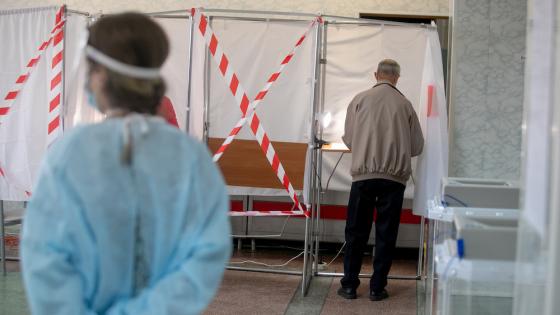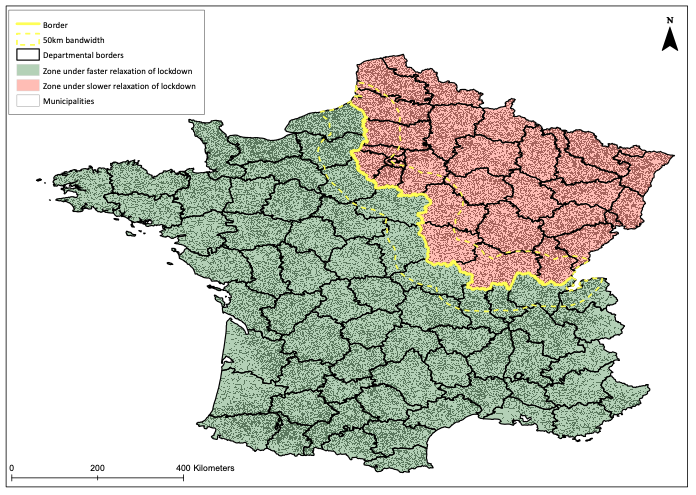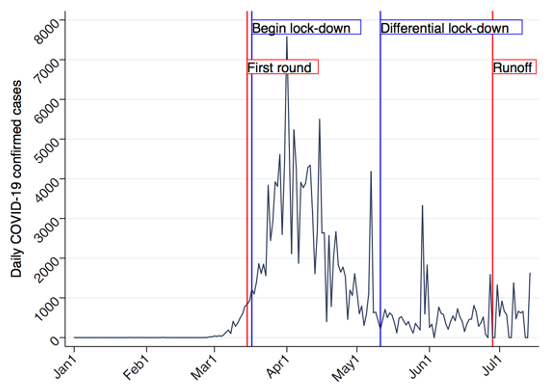The COVID-19 pandemic has led governments to face a global health crisis that threatens the life of millions of people in the world and seriously undermines economic development (Baldwin and Weber di Mauro 2020, McKibbin and Fernando 2020). A common reaction to the insurgence of the pandemic has been the implementation of a set of social containment measures, known as ‘lockdowns’, with the goal of limiting the spread of the disease.1 While these measures represent an effective tool to contain the diffusion of the virus (Born et al. 2020), they limit individual liberty and constrain economic activity (Palomino et al. 2020, Fana et al. 2020).
Given the unprecedented nature of this challenge, it appears crucial to understand how voters react to the introduction of lockdown policies. The electoral consequences will determine who will be in charge of managing the post-pandemic period, as well as any virus resurgence.2 In a recent paper, we study the causal short-term effects of lockdown measures on voting behaviour (Giommoni and Loumeau 2020). We rely on a natural experiment taking place in France during the COVID-19 outbreak, which sees the implementation of differential lockdown across French departments and the delay of the second round of municipal elections.
Lockdown and local elections in France
Similar to other European countries, France was severely affected by the pandemic, with 173,304 confirmed COVID-19 cases and 30,120 total casualties as of 15 July 2020. The French government introduced lockdown measures before the surge of the pandemic, on 17 March. These consisted of a series of restrictions, including the closure of most public establishments, such as schools and universities, and a ban on unnecessary travel. After the pandemic reached the contagion peak in April, the government decided to start loosening the restrictions, but the relaxation was not uniform across French departments. In particular, the French territory was divided into two areas – a green one and a red one – depending on the local severity of the pandemic. The assignment to either area was based on an arbitrary threshold defined by four local health criteria. The departments in the green zone experienced a faster relaxation (‘soft’ lockdown) than those in the red one (‘hard’ lockdown). In the green zone, travel within 100km was allowed again and economic activity restarted, while in the red zone, the stringent restrictions remained in force (Figure 1). This division remained effective from 11 May to 2 June. By focusing on municipalities around the lockdown border, we can analyse the impact of restriction measures on electoral outcomes in similar areas with a comparable local health situation.
Figure 1 Differential lockdown from 11 May to 2 June 2020
The delay of the second round of the 2020 municipal elections due to the pandemic allows us to measure voting behaviour of French voters immediately after the lockdown. The first round of the polls went ahead on 15 March but the introduction of the lockdown two days after the elections impeded the implementation of the second round, which was delayed until the conclusion of the restrictions on 28 June. This unique setting allows us to evaluate the voting behaviour of French voters just before (in the first round) and just after (in the second round) the introduction of the lockdown. Figure 2 displays the trend of the COVID-19 cases in France from 1 January to 15 July 2020 and highlights the timing of 2020 municipal elections as well as the evolution of the lockdown policy.
Figure 2 Lockdown policy and local elections in France
Main results
This institutional setting offers unique quasi-natural variation which can be exploited to estimate the causal effect of lockdown restrictions on electoral outcomes. We compare cities located across the border, and then subject to different rules, just before and just after the implementation of the lockdown (in a spatial regression discontinuity design analysis).
The main results suggest that the severity of the lockdown significantly affected electoral outcomes and voting behaviour. First, we find that localities subject to ‘hard’ restrictions have significantly different voting patterns compared to those under ‘soft’ measures. Municipalities in the red zone exhibit stronger support for the local incumbent, whose vote share is between 2 and 4.5 percentage points higher. The higher visibility of the mayors in the red zone, as well as their important role played in the management of the emergency, may have contributed to increasing their local popularity and electoral success. This result is in line with the ‘rally around the flag’ hypothesis (Mueller 1970, Baum 2002) that trust in leaders tends to raise in the wake of disasters. Voters in areas with longer restrictions may either feel safer or be more aware of the health crisis, and therefore grateful for the policy.
Second, we find that the enforcement of a ‘hard’ lockdown raises political participation (measured by voter turnout). Being subject to a longer lockdown seems to mobilise voters who are motivated to choose the right leader, rather than discouraging them to participate out of fear of the disease. This renewed motivation for political participation may be due to the perception that political institutions are crucial actors in the management of this health crisis, but also to the desire to take part again to the decision process after having suffered a temporary suspension of individual liberties.
These results may be due to the implementation of the two lockdown policies or to actual differences in the health situation in the two zones. We are able to rule out the latter by looking at the departmental data on the number of cases by COVID-19 during the periods preceding the first and second round of elections – we do not observe large differences in the severity of the health crisis between the two zones for the departments close to the border. Therefore, in our sample of municipalities, we can interpret the main results as primarily due to the different containment measures.
Concluding remarks
We analyse the differential lockdown in France and the causal impact of this policy on electoral outcomes, exploiting the delay of the second round of local elections. We find that being subject to a stricter lockdown policy favours the local incumbent. Moreover, it emerges that in areas under a ‘hard’ lockdown, citizens are more likely to vote.
These findings suggest that voters tended to rally around their incumbent politicians during the hardest moment of the pandemic and this may have increased political stability as well as loyalty towards political institutions. This legitimises the imposition of such limitations and may have important consequences in terms of political stability in the aftermath of the crisis. In terms of external validity, lockdown policies have been imposed on millions of individuals in the world, but the impact of these restrictions on the approval of governments clearly depends on many local factors such as the success in the management of the crisis as well as the specific policies implemented.
References
Baldwin, R and B Weder di Mauro (2020), Mitigating the COVID Economic Crisis: Act Fast and Do Whatever It Takes, CEPR Press.
Baum, M A (2002), “The constituent foundations of the rally-round-the-flag phenomenon”, International Studies Quarterly 46(2): 263–298.
Born, B, A Dietrich and G Müller (2020),” The lockdown effect: A counterfactual for Sweden”, CEPR Discussion Paper 14744.
Fana, M, S Tolan, S Torrejón, C Urzi Brancati and E Fernández-Macías (2020), The COVID confinement measures and EU labour markets, Publications Office of the European Union.
Giommoni, T and G Loumeau (2020),” Lockdown and voting behaviour: A natural experiment on postponed elections during the COVID-19 pandemic”, Covid Economics 41.
McKibbin, W and R Fernando (2020), “The economic impact of COVID-19”, in R Baldinw and B Weder di Mauro (eds), Economics in the Time of COVID-19, CEPR Press.
Mueller, J E (1970), “Presidential popularity from Truman to Johnson”, The American Political Science Review 64(1): 18–34.
Palomino, J C, J G Rodríguez and R Sebastian (2020), “Wage inequality and poverty effects of lockdown and social distancing in Europe”, Covid Economics 25.
Endnotes
1 Lockdown measures have been implemented by many European countries: Italy (9 March), Spain (15 March), Austria (17 March), France (17 March), Denmark (18 March), Germany (22 March), Greece (23 March), the Netherlands (24 March), and the UK (24 March).
2 Many countries have been forced to introduce new restrictions due to the hike in COVID cases after the summer (e.g. Israel, Spain).




